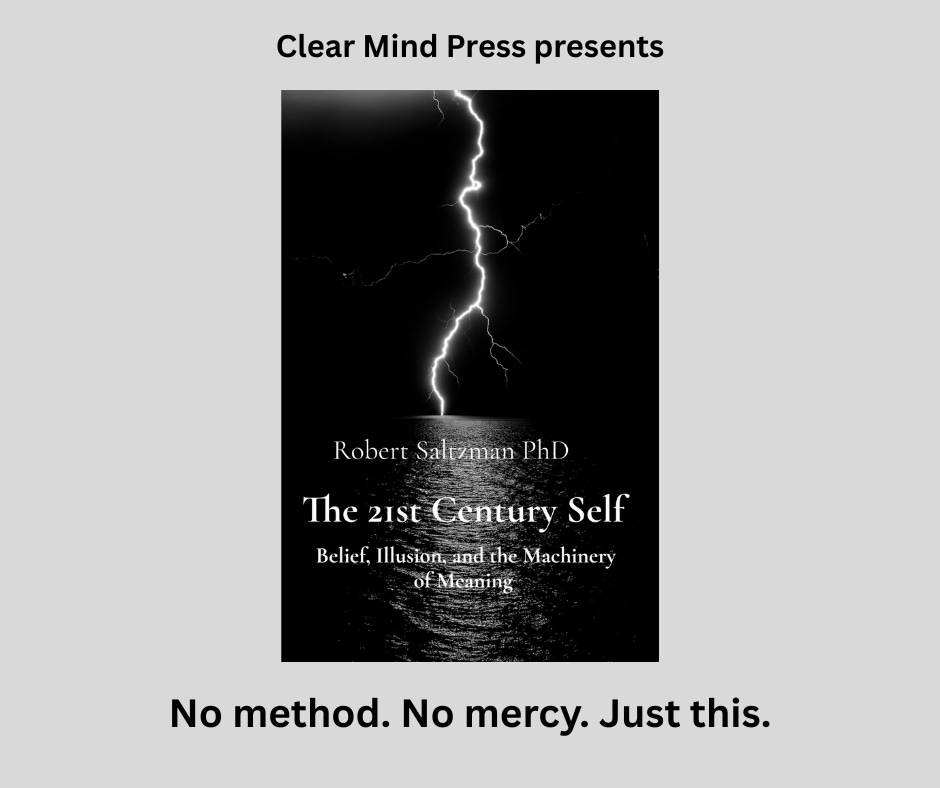Donald is the performer and the performance. He starts a phrase, interrupts himself, repeats it louder, gestures, scowls, gets applause, and says it again. Not because there’s more to say, but because something in him insists it be said again. It doesn’t feel deliberate. It feels like pressure—like the need to keep the balloon inflated or it might all collapse.
He’s not speaking to explain. He’s reacting to the loop he’s already in: him → audience → attention → him again. The words are secondary. What matters is keeping the circuit active.
That’s what gives the performance its strange power. The more he repeats himself, the more the whole thing takes on weight—not because it reveals anything new, but because repetition itself begins to mean there was something solid to start with. There wasn’t. There’s just the loop.
This loop didn’t start with Donald, and it doesn’t end with him either. The machinery was already running—media, politics, outrage, attention. He just stepped into it and let it shape him. Or maybe he shaped it. Doesn’t matter. Either way, the system likes what he brings: noise, reaction, repetition.
What Colbert is exposing isn’t strategy. It’s survival. The story keeps repeating because that’s how the loop holds together. Say something loud, say it again, point at the enemy, ride the response. He not talking to move forward, but to keep from falling through the floor.
Every sentence circles back to justify the last one. Every gesture proves he’s still in charge. That’s the real job—not leading or persuading, but maintaining the story. The same story, looping back on itself. And when the loop tightens, it feels more real, even if it’s just noise.
It’s easy to point at Donald, but this dynamic isn’t his invention. It’s how people work. We all run loops. Old arguments, fears, and desires. Stories we can’t stop telling. Donald just makes the pattern louder. So loud, in fact, that it stops sounding like a story and starts feeling like reality.
That’s the discomfort. If I watch him long enough, I don’t just see him. I start seeing the loop itself—the loop we call Donald—and I’m reminded of something uncomfortably familiar.
I recognize it because I’m in a loop too. We all are. But his runs differently from mine. Mine bends toward lucidity—his toward control. That’s not because I’m better. It’s not even a choice. Same machinery, just different contents.
Like mine, Donald’s loop may include awareness, calibration, even a kind of instinctual intelligence. But its aim is different. It moves toward control, not clarity. Toward dominance, not understanding. That’s not a moral failure. It’s just the shape that loop takes under pressure. Mine bends toward lucidity—whether through language or photography—because that’s how it maintains shape. Not because I chose it. Not because it’s better. Same machinery, different contents. No one behind it. But the pattern matters.
This isn’t about whether Donald is good or bad, smart or stupid. It’s about watching a structure in motion—one that stabilizes by reinforcing itself. What looks like a performance isn’t covering anything up. It is the person. There’s no one behind it. Just the loop, looping.
And there’s no use pretending that “awareness” sits outside the loop. Donald can’t choose to be more aware than he is. There’s no one out there to make the choice. Awareness is part of the loop—just like denial, ambition, or cruelty. If Donald’s loop lacks self-reflection, it’s not because he failed. It’s because that wasn’t reinforced. And if mine includes a recursive self-check, that too is just a feature—not an achievement.
We come to the question that floats just beneath all this: can ethics arise in a system with no self? No commander, no soul, no one at the wheel? We’re used to imagining morality as a thing someone does. But what if it’s just a kind of pattern—what the loop does when it no longer orients solely around self-protection, self-expansion, or self-justification.
When the loop begins to notice itself, to include others in its recursive modeling—not as props or threats, but as equally pressurized loops
Donald and I grew up five miles apart. We’re nearly the same age. His childhood was brutal. His father was a public supporter of Nazi ideology. He taught Donald to dominate, to win at all costs —lie, cheat, bulldoze —whatever it took. Add millions of dollars from daddy and zero resistance, and the loop tightens fast. There’s no space for reflection when performance keeps paying.
My loop bent a different way. I find satisfaction in clarity, not conquest. As a photographer, I don’t try to dominate the scene. I don’t want to bruise the scene, as Joel Myerowitz put it. I notice it. Prepare, wait, press the shutter. I’m not angling for control. I’m tuning into something.
Donald’s loop may lack self-reflection. He doesn’t question the loop because the loop rewards him. Money, attention, power, rage—all arrive as confirmation. The loop confirms itself.
And if you think that’s not a loop, just watch what happens when it’s challenged. Rage. Denial. Projection. Retaliation. The same moves, over and over. The same shallow performance of strength. It’s not a strategy. It’s a stabilizing mechanism. The loop defends itself.
But I see his loop. I see how it stabilizes. The loop doesn’t care about truth. It doesn’t care about harm. It cares about reinforcement. About survival. And if it’s never interrupted, it believes itself.
That’s what troubles me most—not his egregious beliefs, but their coherence. They form a loop, and because it loops, it believes itself. The mirror says, “You again!” and he takes it for proof.
Books By Robert:
The Ten Thousand Things
Depending On No-Thing
Understanding Claude
The 21st Century Self

